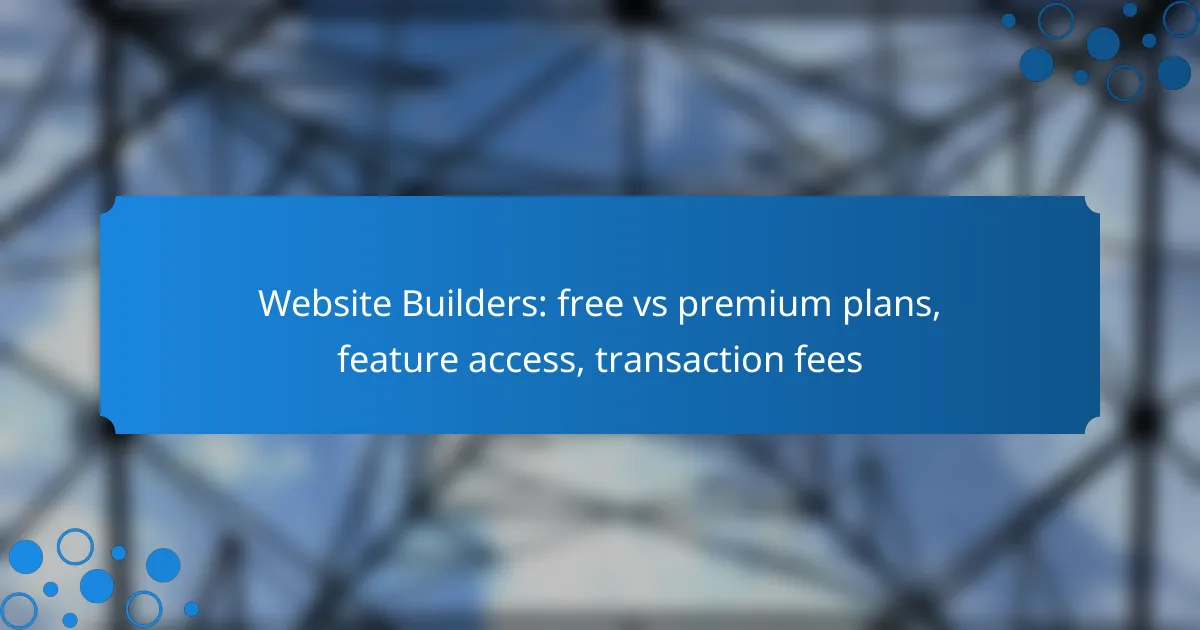When choosing a website builder, users often face the decision between free and premium plans, each offering distinct advantages. Free plans provide basic functionalities suitable for personal projects, while premium options unlock advanced features like custom domains and eCommerce tools. Understanding the trade-offs, including potential transaction fees and feature access, is essential for making an informed choice that aligns with your online goals.
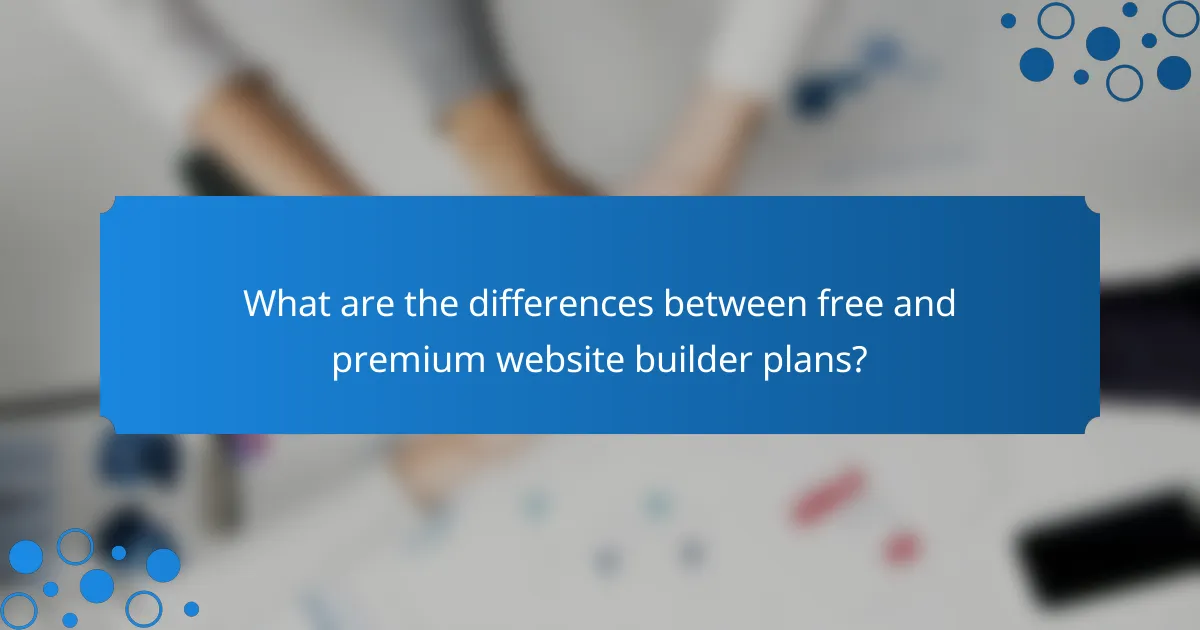
What are the differences between free and premium website builder plans?
Free website builder plans typically offer limited features and functionalities compared to premium plans, which provide a broader range of tools and capabilities. Users must weigh the trade-offs between cost savings and the benefits of enhanced features when choosing between these options.
Free plan limitations
Free plans often come with significant restrictions, such as limited storage space, fewer templates, and basic customer support. Users may also encounter branding from the website builder, which can detract from a professional appearance.
Additionally, many free plans impose transaction fees on e-commerce activities, limiting the potential profitability of online sales. This can be a critical drawback for businesses looking to grow their online presence.
Premium plan advantages
Premium plans generally offer enhanced features like custom domain names, advanced analytics, and priority customer support. These benefits can significantly improve user experience and site performance, making them ideal for serious businesses.
Moreover, premium plans often eliminate transaction fees, allowing users to retain more revenue from sales. This can be a substantial advantage for e-commerce sites aiming for profitability.
Cost comparison
Free plans are, as the name suggests, without cost, but they may lead to hidden expenses due to transaction fees and limited capabilities. Premium plans typically range from around $5 to $50 per month, depending on the features included.
When considering the total cost of ownership, it’s essential to evaluate the potential revenue loss from transaction fees on free plans against the monthly fees of premium plans. For many businesses, investing in a premium plan can lead to better long-term financial outcomes.
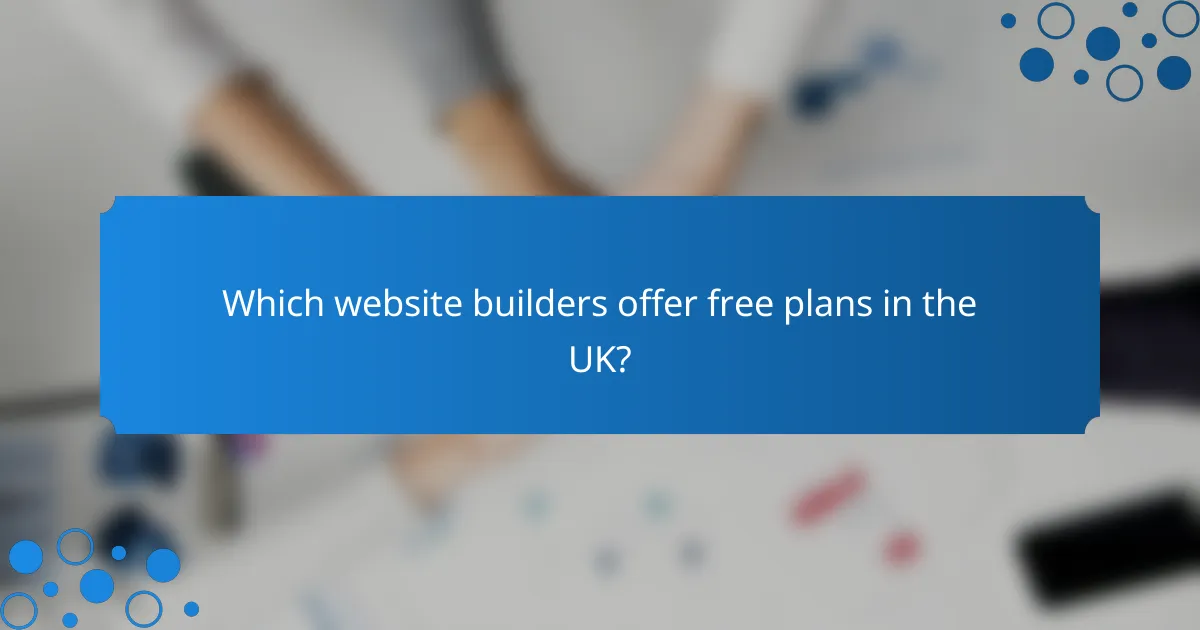
Which website builders offer free plans in the UK?
Several website builders in the UK offer free plans, allowing users to create websites without upfront costs. Popular options include Wix, Weebly, and WordPress.com, each providing a range of features with their free offerings.
Wix free plan features
The Wix free plan allows users to build a website using a drag-and-drop interface, making it user-friendly for beginners. Users can access hundreds of templates and basic features, but their site will display Wix ads and a Wix domain name.
Key limitations include a storage capacity of around 500 MB and bandwidth restrictions, which may not be suitable for high-traffic sites. Additionally, e-commerce functionalities are not available on the free plan.
Weebly free plan features
Weebly’s free plan offers a simple website creation experience with a selection of customizable templates. Users can create a basic online store, but they will face transaction fees on sales made through the site.
This plan includes features like 500 MB of storage and a Weebly-branded domain. However, advanced features such as password protection and site search are reserved for paid plans.
WordPress.com free plan features
The WordPress.com free plan is ideal for bloggers and content creators, providing a user-friendly interface and access to a variety of themes. Users can publish posts and pages but will have a WordPress.com subdomain and ads displayed on their site.
Storage is limited to 3 GB, which is sufficient for text and images but may be restrictive for larger media files. E-commerce capabilities are not included, making it less suitable for online stores without upgrading to a premium plan.
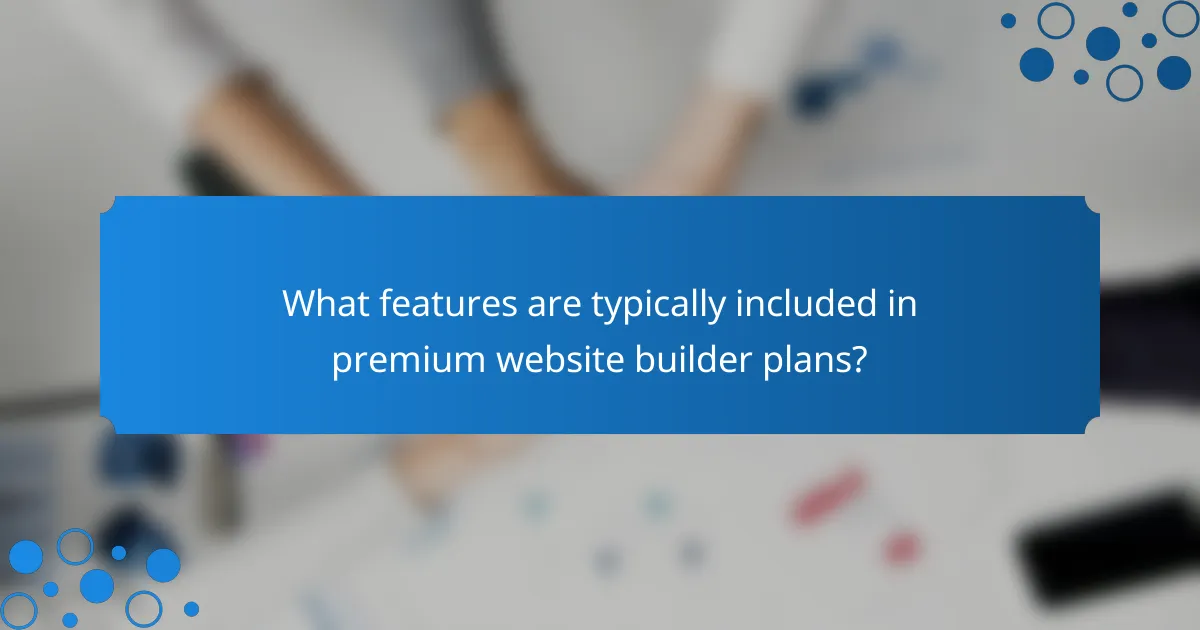
What features are typically included in premium website builder plans?
Premium website builder plans usually offer enhanced features that free plans lack, such as custom domain access, advanced SEO tools, and eCommerce capabilities. These features are designed to provide greater flexibility, improved performance, and better branding opportunities for users looking to establish a professional online presence.
Custom domain access
Premium plans typically allow users to connect a custom domain, which is essential for branding and credibility. Instead of using a subdomain (like yoursite.builder.com), you can use a personalized domain (like yoursite.com), making your website appear more professional.
When selecting a domain, consider the name’s relevance to your brand and its memorability. Most website builders offer domain registration services, often at an additional cost, so check if this is included in your premium plan.
Advanced SEO tools
Advanced SEO tools in premium plans help optimize your website for search engines, improving visibility and traffic. Features may include customizable meta tags, advanced analytics, and integration with third-party SEO tools.
Utilizing these tools effectively can significantly enhance your site’s ranking on search engines like Google. Look for features such as keyword tracking and performance reports to gauge your SEO efforts.
eCommerce capabilities
Premium website builders often include robust eCommerce features, enabling users to set up online stores. This may encompass payment processing, inventory management, and customizable product pages, which are essential for selling products or services online.
When choosing a plan, consider transaction fees associated with payment gateways, as these can impact your overall profitability. Many premium plans offer lower fees or even no fees on transactions, making them more attractive for serious online retailers.
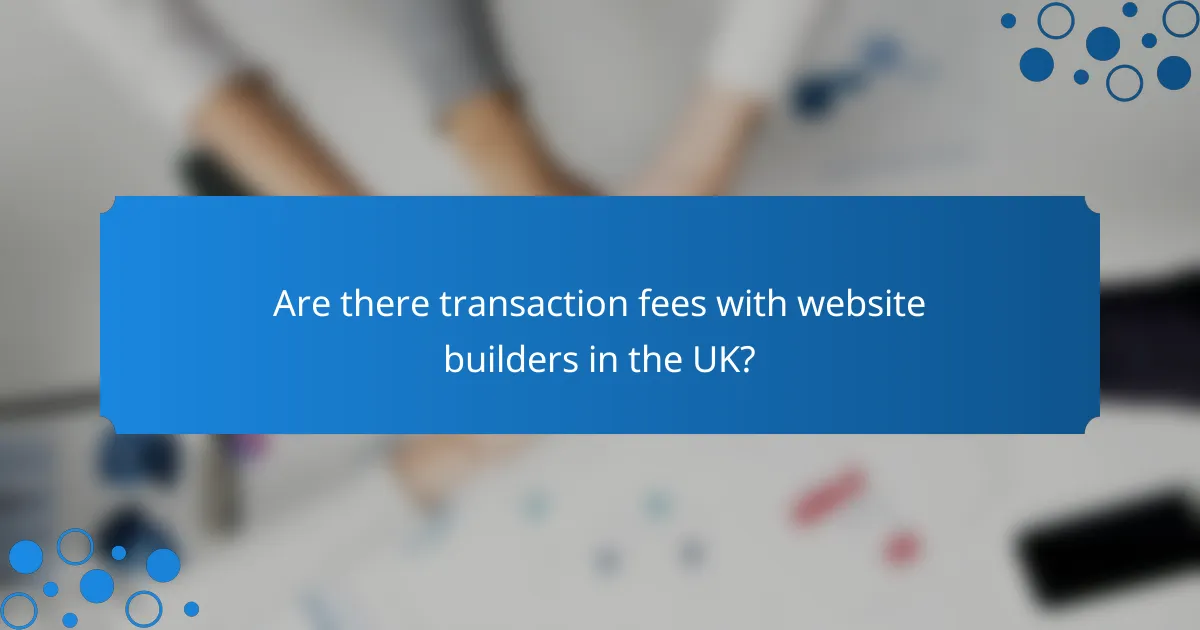
Are there transaction fees with website builders in the UK?
Yes, many website builders in the UK impose transaction fees, particularly on e-commerce plans. These fees can vary based on the platform and the specific plan you choose, impacting your overall costs when selling products online.
Wix transaction fees
Wix does not charge transaction fees on its e-commerce plans, which is a significant advantage for online sellers. However, users should be aware that payment processors like PayPal or Stripe may have their own fees, typically around 1.4% to 3.4% per transaction, depending on the payment method and volume.
For those using the free plan, Wix does not allow e-commerce functionality, so upgrading to a paid plan is necessary to sell products online without incurring additional fees from Wix itself.
Squarespace transaction fees
Squarespace charges transaction fees on its lower-tier plans, typically around 3% for sales made through the platform. However, if you opt for the Business plan or higher, these fees are waived, allowing you to keep more of your sales revenue.
It’s essential to consider that Squarespace’s payment processing fees, which can range from 2.9% + £0.20 per transaction for Stripe, will still apply regardless of the plan you choose.
Shopify transaction fees
Shopify has a tiered fee structure for its plans, with transaction fees ranging from 0% to 2% depending on the plan selected. Users on the Basic plan face a 2% fee, while those on the Shopify plan pay 1%, and the Advanced plan has a 0.5% fee.
Shopify also offers the option to use its own payment processor, Shopify Payments, which eliminates these transaction fees entirely. However, if you choose to use a third-party payment processor, you will incur the aforementioned fees in addition to the processor’s charges.
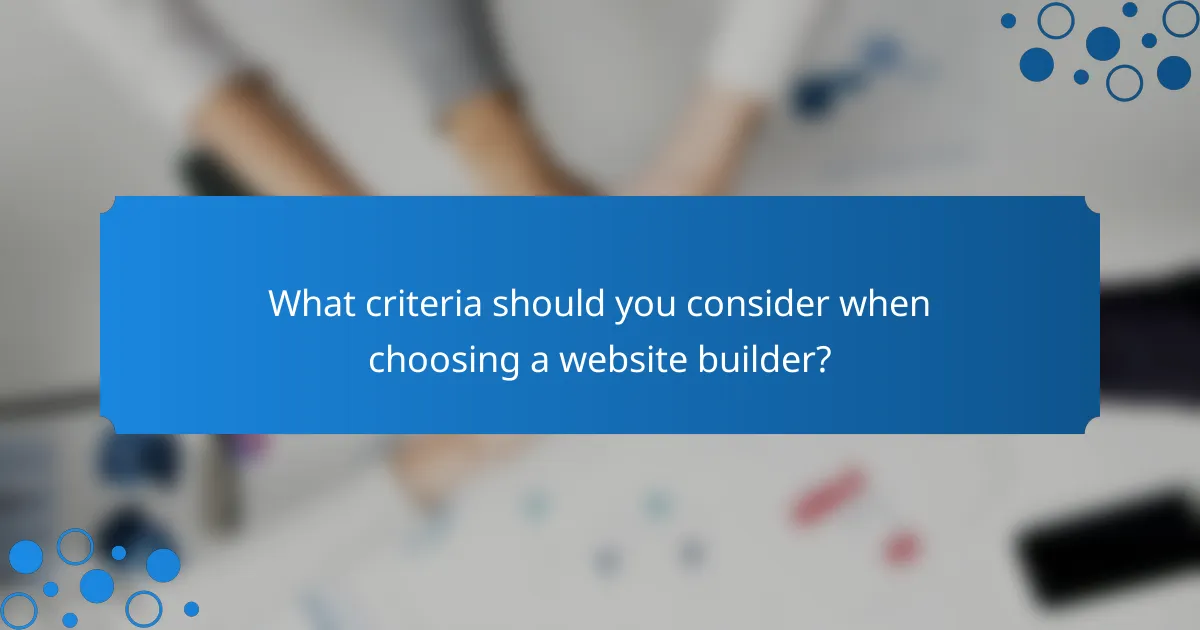
What criteria should you consider when choosing a website builder?
When selecting a website builder, consider factors such as your target audience, integration capabilities, and scalability options. These criteria will help ensure that the platform meets your specific needs and can grow with your business.
Target audience needs
Understanding your target audience is crucial when choosing a website builder. Consider their preferences, technical skills, and the devices they use to access your site. For instance, if your audience primarily uses mobile devices, ensure the builder offers responsive design features.
Additionally, think about the content types your audience engages with. If you plan to showcase a lot of visual content, select a builder that provides strong multimedia support and customization options.
Integration capabilities
Integration capabilities determine how well your website can connect with other tools and services. Look for a builder that supports essential integrations, such as payment gateways, email marketing platforms, and social media channels. This will streamline your operations and enhance user experience.
For example, if you plan to sell products online, ensure the website builder can integrate with popular e-commerce solutions like Shopify or WooCommerce. This can save you time and reduce transaction fees associated with third-party services.
Scalability options
Scalability options are vital for future growth. Choose a website builder that allows you to easily upgrade your plan or add features as your business expands. This flexibility can save you the hassle of migrating to a new platform later.
Assess whether the builder can handle increased traffic and additional functionalities without performance issues. For instance, if you anticipate high traffic, select a builder known for robust hosting solutions that can accommodate spikes in visitors.

What are the emerging trends in website builders?
Emerging trends in website builders focus on enhancing user experience through automation, customization, and integration of advanced technologies. Features like AI-driven design tools and improved e-commerce functionalities are becoming standard, catering to diverse user needs.
AI-driven design tools
AI-driven design tools streamline the website creation process by automating layout and design choices based on user preferences and content type. These tools analyze existing websites and suggest design elements that enhance visual appeal and functionality.
For instance, platforms like Wix and Squarespace offer AI assistants that help users create a personalized site in minutes. Users simply input their business type and preferences, and the AI generates a tailored design, saving time and reducing the need for technical skills.
When using AI-driven tools, consider the balance between automation and customization. While AI can simplify design, ensure you still have control over key elements to maintain brand identity. Avoid relying solely on AI suggestions; always review and adjust to fit your vision.
